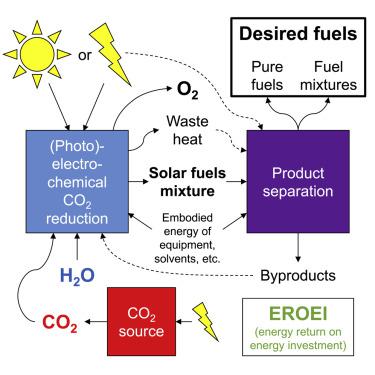Joule ( IF 38.6 ) Pub Date : 2018-02-20 , DOI: 10.1016/j.joule.2018.01.014 Jeffery B. Greenblatt , Daniel J. Miller , Joel W. Ager , Frances A. Houle , Ian D. Sharp

|
Known catalysts for (photo)electrochemical carbon dioxide (CO2) reduction typically generate multiple products, including hydrogen, carbon monoxide, hydrocarbons, and oxygenates, making product separation a ubiquitous, yet often overlooked, challenge. Here, we review CO2 reduction products using available catalysts and discuss approaches for product separation along with estimates of separation energy requirements. We illustrate potential complexities and discuss opportunities to minimize separations by utilizing product mixtures. We also examine potential CO2 sources, their energy requirements, and net CO2 emissions. Finally, we discuss use of waste energy sources and integrate this information into an overall energy balance assessment. Using a common sustainability metric, energy return on energy investment (EROEI), we find that an EROEI of ∼2.0 may be possible, before including separation and CO2 production energy. For EROEI to remain above one (the break-even point), these additional energy requirements, including embodied energy of equipment, must be no greater than half of the product energy.
中文翻译:

分离(照片)电化学二氧化碳减排产品的技术和能源挑战
已知的用于(光)电化学二氧化碳(CO 2)还原的催化剂通常产生多种产物,包括氢,一氧化碳,碳氢化合物和含氧化合物,使得产物分离成为普遍存在的但经常被忽视的挑战。在这里,我们回顾了使用可用催化剂的CO 2还原产物,并讨论了产物分离的方法以及分离能量需求的估算。我们举例说明了潜在的复杂性,并讨论了通过利用产品混合物来最大程度减少分离的机会。我们还将检查潜在的CO 2来源,其能源需求和净CO 2排放。最后,我们讨论了废物能源的使用,并将此信息整合到总体能源平衡评估中。使用通用的可持续性度量标准,即能源投资的能源回报(EROEI),我们发现在包括分离和CO 2生产能源之前,EROEI可能约为2.0 。为了使EROEI保持在一个以上(盈亏平衡点),这些额外的能量要求(包括设备的内含能量)必须不大于产品能量的一半。











































 京公网安备 11010802027423号
京公网安备 11010802027423号